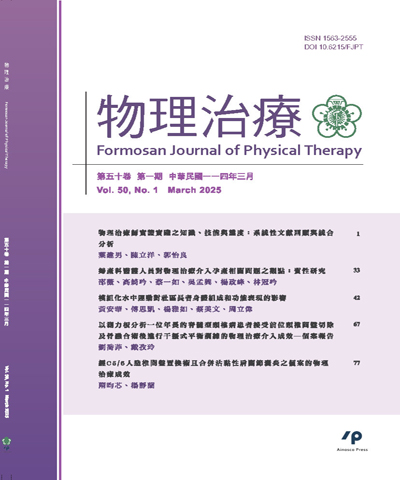
物理治療/Formosan Journal of Physical Therapy
社團法人臺灣物理治療學會 & Ainosco Press,正常發行
選擇卷期
- 期刊
背景與目的:依據教學醫院評鑑基準(第6.1節)所示,醫院應提供實習學生有系統之臨床教學訓練,確保訓練之執行與成果評估。本研究探討個案醫院藉由Google教育應用程式建構物理治療實習訓練平臺,促進師生間雙向回饋、協同合作。方法:個案醫院採用免費Google Classroom建置雲端管理系統,於2016年11月進行物理治療實習生訓練,以三位老師及一位實習學生試行,並且藉由G Suite資源說明中心協助疑難排解。於2017年3月衡量使用者經驗的無形層面,採用Benedek和Miner開發產品反應卡(product reaction card),讓使用者在相關單詞中選出最能形容Google Classroom的5個描述,以評估application (App)易用性。以一題項衡量整體滿意度("1"表非常不滿意 ~ "5"表非常滿意)。結果:4名使用者對於Google Classroom平臺評價,所選擇形容詞為合作(4次)、有效率(3次)、好用(3次)、靈活的(3次)、客製的(2次),出現1次的單字為可靠、可獲取、值得擁有、好玩有趣、省時。四名使用者自陳平臺功能整體滿意度平均4.5分。結論:利用Google Classroom設立物治實習學生教學訓練平臺,實現師生多對多之互動與回饋。未來整合跨領域教材讓平臺成為豐富知識庫,並進行遠端視訊溝通,讓雲端教室更臻完善。
- 期刊
背景與目的:頸椎退化性關節炎或椎間盤突出常引發肩頸痠痛,這是常見的疾病之一。近年來,消費性電子產品與日俱增,因不當的使用習慣而造成肩頸疼痛的患者比以往增加,而且年齡層逐漸下降。頸椎病的治療大多採用藥物與復健的保守療法,而頸椎牽引是復健療法中最常見之一。坐式牽引的療效主要受到牽引力量以及牽引角度的影響,其中牽引角度較易在牽引過程中發生角度偏移,本研究將進行其對療效影響之探討。方法:利用三軸加速規監測牽引過程中角度的偏移狀況,並以視覺疼痛類比量表、頸椎功能障礙指數量表、心率變異度分析和頸椎活動度量測儀針對實驗組與對照組進行牽引前後之療效評估。結果:兩組的視覺疼痛類比量表都有明顯差異,但對照組的疼痛緩解程度較大。在頸椎功能障礙指數與心率變異度分析上,對照組有較明顯差異。結論:牽引對疼痛緩解具有明顯療效,但若於牽引過程中發生角度偏移,將會降低牽引之療效。
- 期刊
背景與目的:腰椎牽引為改善椎間盤突出引起的下背痛的治療方式之一。本篇研究欲進行系統性回顧探討當今研究證據是否支持因不同姿勢影響機械式腰椎牽引介入時改善椎間盤突出引起之下背痛治療效果。方法:本篇研究使用PubMed、Cochrane Library、華藝線上圖書館等資料庫,以腰椎椎間盤突出(lumbar disc herniation)、牽引(traction)、姿勢擺位(posture/position)、仰躺(supine)及俯臥(prone)作為關鍵字進行搜尋,搜尋從1986年11月至2016年11月所發表的文章。以英國牛津大學實證醫學中心及皮卓量表評分檢核文獻品質及實證層級。結果:共計65篇,納入條件總計10篇符合進行文獻評析,大多為實證等級2級之研究。無論牽拉姿勢對於多項成效評估具有治療前後之改善。結論:本篇系統性文獻回顧,顯示對於腰椎椎間盤突出病患於腰椎牽引時所採取的姿勢尚無直接比較療效之研究證據,但分別檢視各牽引姿勢(仰躺或俯臥)之腰椎牽引,均呈現改善腰椎椎間盤突出相關症狀包括結構、神經症狀、生活障礙之功能程度等之成效。
- 期刊
Background and Purpose: Foot orthosis is often introduced in conjunction with physiotherapy to correct faulty foot postures and enhance motor function for children with hypotonia; however, the effects of stabilizing foot splints (SFSs) remain largely unexplored. This study aimed to examine the effects of physiotherapy and custom-modified SFSs on standing balance and mobility in children with hypotonia and developmental delay who could stand alone but could not walk independently yet over a three-week intervention period. Methods: Eleven participants (19.4 ± 2.9 months) were prospectively enrolled. All participants were provided 40-minute physiotherapy once a week that aimed at improving their strength, balance, sensorimotor organization, and functional mobility and parents were advised to have their child wear custom-modified SFSs during standing activities at home for at least 2 hours a day. Outcome variables examined included the amount of time that the participants could independently stand, the path length and the area of center of pressure (COP) excursions while standing steadily, the sum of scores on selected standing mobility items of the locomotion subtest of Peabody Developmental Motor Scale-II, and the number of steps that the participants could walk independently without falling. All outcomes measured while barefoot before and after a three-week intervention period were examined and compared. Results: Results of Wilcoxon Signed Rank Test revealed significant improvements in standing balance and mobility after three-week intervention, including a longer duration of standing time, a smaller postural sway area while standing, higher scores on standing mobility, and greater number of steps of independent walking. Conclusions: The present results showed that children with hypotonia and developmental delay who could stand alone but could not walk independently might benefit from the three-week intervention involving use of custom-modified SFSs and physiotherapy and exhibited improved standing balance and mobility even without the subsequent aid of custom-modified SFSs. However, findings of this study were preliminary and we could not exclude the result of developmental maturation; further study with more rigorous study design is warranted. Results obtained may assist physical therapists and parents in making orthotic decision when managing children with hypotonia and developmental delay who could stand alone but could not walk independently.
- 期刊
背景與目的:物理治療被證實可以改善退化性小腦損傷患者的動作功能。不過,這類研究目前只侷限在輕微損傷患者,且鮮少提供個別化治療策略。本個案報告目的在探討以動作再學習計畫為基礎的個別化介入,對嚴重退化性小腦共濟失調個案的臨床效益。方法:一位68歲男性、散發型小腦共濟失調個案,多年依賴輪椅移行。根據動作再學習計畫四步驟,找出個案特有動作缺失成分,並提供個別化任務導向訓練。訓練時間共8週,每週3次,每次45 ~ 60分鐘。以共濟失調等級量表、柏格氏平衡量表、巴氏量表、10 m行走測試與步態等評估動作功能。結果:經過8週訓練,在共濟失調等級量表、柏格氏平衡量表與巴氏量表上,個案進步分數分別是6分、16分與15分。10 m行走測試,在使用助行器下,由最大協助進步到接觸保護,且完成時間由300秒進步到181秒。此外,個案行走時重心轉移能力有改善,左腳步伐變大,對跌倒恐懼明顯降低。個案自覺生活品質有很大改善。結論:依據動作再學習計畫擬定的個別化訓練,有助於嚴重退化性小腦共濟失調患者之平衡、坐站及行走等動作功能表現。以動作再學習計畫提供個別化訓練是可行且有臨床效益,本個案報告可提供未來治療嚴重退化性小腦疾病的決策思考方向。
- 期刊
背景與目的:下背痛(low back pain)為一好發的肌肉骨骼疾病,過去已有許多文獻證實能改善疼痛與日常生活功能。然而,在下背痛族群中仍有許多個案無法改善症狀,有些學者認為這樣的族群與臀部肌肉控制不佳和肌肉失衡相關之長短腳有所連結。因此本研究目的為探討額外增加臀部肌群控制訓練對改善有功能性長短腳之下背痛患者的療效。方法:本研究為前瞻性單盲隨機控制實驗,招募慢性下背痛個案60人,受試者將隨機分派成兩組:實驗組為臀肌訓練組(gluteal control training, GT)、控制組為一般介入組(regular training, RT)。兩組皆接受儀器治療、牽拉運動、一般核心肌群訓練,而實驗組部分再加上臀部肌群控制訓練。本實驗之主要成效評估包含視覺類比量表(Visual Analogue Scale, VAS)、歐式失能量表 (Oswestry Disability Index, ODI)與病患自覺功能量表(Patient-Specific Functional Scale, PSFS)。次要成效評估包括雙側下肢肌力、肌肉柔軟度、功能性腳長差異、髂骨兩側旋轉角度差異。以上成效結果評估會於接受治療6週後再進行總評估。結果:目前已有10位完成前測評估與4週介入,其實驗組於介入後在功能性腳長差異(前測:0.9 ± 0.2 cm;後測:0.31 ± 0.17 cm)較控制組(前測:0.92 ± 0.06 cm;後測:0.61 ± 0.19 cm)有顯著改變(p = 0.02)。結論:本研究顯示下背痛患者於4週療程中額外增加臀部肌群控制訓練較可改善功能性長短腳的臨床表現。臨床意義:部分下背痛患者因臀部肌肉控制不佳和肌肉失衡引起功能性長短腳的問題導致症狀恢復不良,本研究結果僅指出額外增加臀部肌群訓練可改善功能 性長短腳現象,於其他面向之效果則有待後續研究完成後確認。
- 期刊
Background and Purpose: Nonspecific shoulder/ arm pain is characterized by an absence of objective physical findings and usually its symptoms do not correspond with objective pathophysiology. Previous studies show that non-specific shoulder/arm pain is associated with neurobiomechanical factor which is related to an anterior shear force of cervical vertebra occurring during the movement of cervical flexion. Thus, cervical mobilization with anterior to posterior (AP) glides of the cervical spine can be more specific to treat the symptoms resulting from the anterior shear force of vertebrae. However, very few studies have been found to investigate its effectiveness. The purposes of this study are: (1) To determine the immediate effectiveness of cervical AP glide mobilization on decreasing pain, increasing shoulder strength and improving function in patients with non-specific shoulder/arm pain; (2) To determine the additional effectiveness of cervical lateral glide mobilization on decreasing pain, increasing shoulder strength in patients with non-specific shoulder/arm pain. Methods: This is a randomized control trial. We plan to recruit 78 subjects who suffer from nonspecific shoulder/arm pain (pain scale ≥ 3). Up to now, nine participants have completed this study. Subjects were randomly assigned into AP glide group (n = 4), AP glide plus lateral glide group (n = 3) and control group (n = 2). The control group received placebo stroke massage on their cervical spine. Outcome measures including shoulder muscle strength and pain intensity were assessed before and immediately after the intervention. We calculated the change scores (the differences between the scores at baseline and post-treatment) for all outcome measures. Then we used one-way analysis of variance (ANOVA) to determine the between-group differences for all outcomes. Results: There was a significant difference of the change score in muscle strength (shoulder abductor: p = 0.014) among three groups. The AP glide group demonstrated more improvement than the control group in shoulder abduction strength (p = 0.006). The AP plus lateral glide group also showed significantly more improvement than the control group in shoulder abduction strength (p = 0.011) and shoulder flexion strength (p = 0.031). For the pain intensity, a tendency towards significance was found (p = 0.081) among three groups. Conclusion: Cervical mobilization with AP glide showed immediate effects on increasing shoulder strength. The study is still ongoing. More subjects are needed to determine the effectiveness of cervical AP glide mobilization and additional effectiveness of cervical lateral glide mobilization on pain and function in patients with non-specific shoulder/arm pain. Clinical Relevance: This preliminary study reveals that cervical AP glide mobilization shows a tendency towards more positively influencing patients with non-specific shoulder/arm pain on muscle strength.
- 期刊
背景與目的:動作產生需仰賴本體感覺系統(proprioceptive system)、視覺系統(visual system)、前庭系統(vestibular system)不斷地給予修正及回饋,做出適當的調整;前十字韌帶(anterior cruciate ligament, ACL)受傷的病患,由於本體感覺受器(proprioception receptors)受損,動作執行轉為依賴視覺回饋做代償,一旦剝奪視覺回饋,在姿勢及動作控制上,容易出現困難。前十字韌帶術後的傳統復健計畫,著重神經肌肉訓練(neuromuscular training),儘管許多文獻證實其效益,但這樣的復健計畫,並未考慮病患受傷後,過於依賴視覺回饋的動作模式。因此,在治療介入當中減少視覺回饋,矯正依賴視覺回饋的代償機制,有利於病患後續的功能恢復、有效降低再次受傷的機會。方法:本案例為一位35歲男性,右膝前十字韌帶完全斷裂,接受了取膕旁肌(hamstring)肌腱來做的重建手術,術後第四週開始物理治療介入。初步評估顯示個案右膝關節活動度受限、右側下肢肌力不足;分析步態,於站立期(stance phase)的中期無膝伸直(terminal extension)、末期無推進(push-off)動作;於擺盪期(swing phase)為環形步態(circumduction gait)。根據前述觀點及個案主要問題,擬定出為期三週的治療計畫。治療計畫包含:關節被動牽拉、髕骨鬆動術、肌力訓練、利用治療球做膝關節穩定度訓練,並於治療過程中增加動作困難度,例如搭配上肢活動、閉眼睛、記憶遊戲及倒退走跨越障礙物,分散個案在右膝動作控制上的視覺輸入。本篇研究使用星狀延展平衡測試(Star Excursion Balance Test, SEBT)、睜眼及閉眼單腳站立、下肢最大肌力測 試及運動本體感覺測試(movement sense)作為介入成效評估工具。結果:個案於介入第二週步態達到正常,能無困難的執行倒退走跨越障礙物這項計畫。星狀延展平衡測試結果,右腳從0 cm進步至55 ± 2.5 cm,達左腳測量值84%;單腳站立測試中,右腳在睜眼及閉眼秒數,前測結果分別為19秒及10秒,後測結果皆大於30秒;下肢最大肌力測得右腳肌力由左腳肌力的68%進步至87.5%;右膝運動本體感覺前測及後測,分別與左膝差10度和5度。結論:本篇研究所擬定出的三週治療計畫,對個案於肌力、離心控制、膝關節穩定度及運動本體感覺皆有正向效果。臨床意義:對於前十字韌帶重建術後的病患,傳統復健計畫著重於患者的肌力恢復,忽略了本體感覺及受傷後動作執行模式的改變,為了有效減低後續再受傷的可能性,使病患恢復較好的生活功能,視覺遮蔽應納入復健計畫當中。
- 期刊
背景與目的:肌筋膜激痛點(myofascial trigger point)是一個現代社會十分普遍的症狀,上斜方肌又是常見會有肌筋膜激痛點的肌肉。本實驗目的為探討超音波治療對上斜方肌激痛點之立即療效,療效評估包括疼痛閥值及肌肉活化情形。相較於過去探討治療對於肌肉激痛點的療效大多使用疼痛閥值作為療效指標,本實驗同時利用轉折振幅分析(turns-amplitude analysis)分析表面肌電訊號以瞭解肌肉活化的情形,藉此瞭解治療是否能改善激痛點對肌肉出力模式所造成的影響。方法:目前前驅實驗共收了六位有上斜方肌激痛點受試者,使用1 MHz、1 W/cm^2、連續波之超音波在上斜方肌激痛點處治療五分鐘。在治療前及治療後立即測量疼痛閥值(痛覺壓力計)及表面肌電圖之訊號。肌電圖貼片沿著肌肉纖維走向貼在上斜方肌激痛點上。接著會請受試者做出聳肩的動作,並請受試者盡最大力維持這個姿勢抵抗測驗人員從肩膀給的下壓力量,共做三次。肌電訊號放大500倍。轉折數(turns)為平均一秒內電位差超過100 μV的數量。轉折振幅(mean amplitude)為平均的轉折振幅大小,本實驗採用最大5%的平均振幅來標準化。結果:疼痛閥值在治療後平均上升9.4% ± 17.9%,效應值(effect size)為0.52(介於中等效應到大效應之間);轉折振幅在治療後平均上升3.3% ± 8.4%,效應值為0.39(介於小效應到中等效應之間);轉折數在治療後則是下降4.2% ± 6.1%,效應值為0.69(介於中等效應到大效應之間);轉折振幅/轉折數比值在治療後上升7.9% ± 13.8%,效應值為0.57(介於中等效應到大效應之間)。結論:治療後疼痛閥值會提升,而肌電訊號分析結果指出肌肉活化情形有上升的趨勢。過去研究觀察肌肉病變之肌電訊號發現轉折數上升及轉折振幅/轉折數比值下降,而本實驗治療完後則是使轉折數下降及轉折振幅/轉折數比值上升,顯示治療完後肌肉功能有所改善。臨床意義:超音波治療對上斜方肌激痛點在疼痛及肌肉活化方面皆有立即療效。
- 期刊
背景與目的:跌倒為影響老年人身心健康與生命安全的重要議題,進行事前的跌倒風險篩檢是防跌策略中不可或缺的一環。相較於傳統常見的跌倒篩檢測試,探討長者之步態表現可能提供更多資訊。本研究目的為:(1)比較低/中/高跌倒風險長者之步態特性與臨床跌倒篩檢測試表現;(2)探討步態參數與臨床跌倒篩檢測試之間的相關性;(3)以多元線性迴歸分析與接受者操作特徵曲線(receiver operating characteristic [ROC] curve)計算且比較步態參數與臨床跌倒篩檢測試對於跌倒風險等級之預測力與鑑別力。方法:本研究招募122位居住於社區或機構、可獨立步行之長者(年齡 > 60歲)及31位作為參考組之青壯年族群(年齡20 ~ 45歲)。以澳洲跌倒風險生理評估系統 (Physiological Profile Assessment, PPA)將受測者進行跌倒風險分級,區分為低、中、高跌倒風險等級,再請受測者接受若干跌倒篩檢測試,含計時起走測試(Timed Up and Go test, TUG)、五次坐站測試(five times sit to stand, FTSS)、Tinetti氏之表現導向行動評量(Performance Oriented Mobility Assessment, POMA),並以穿戴式步態感測器Physilog^®5進行10 m來回之步態檢測。結果:收錄的122名長者平均年齡75.1 ± 9.0歲,女性占64%,PPA低/中/高跌倒風險等級各為36、15與71人。不同跌倒風險等級長者在各項跌倒篩檢測試表現具顯著差異(p < 0.001),以低跌倒風險組長者在TUG、FTSS與POMA測試表現最佳。步態檢測方面,以Physilog^®5所擷取之步態資訊可清楚區辨低/中/高各跌倒風險等級長者在步態特性上的差異;高跌倒風險組相較於低/中跌倒風險組之步態特性,其整體步行速度較慢(p < 0.001)、步頻較低(p = 0.008)、步長較短(p < 0.001)、跨步速度較慢(p < 0.001)、足部角度與高度較小(p < 0.001)、跨步時間/步長變異性較大(p < 0.001/p = 0.002)。PPA跌倒風險分數與整體步態時間空間參數具有低度至中度顯著相關;而TUG、FTSS與POMA對於大部分步態參數的相關性達中度至高度顯著相關。多元線性迴歸分析顯示:認知功能(標準化迴歸係數β = -0.455)、跨步速度(β = -0.201)、教育程度(β = -0.201)、步長變異性(β = 0.156),以及患有疾病數(β = 0.129)為顯著預測PPA跌倒風險分數之因子;使用步態參數(模式二)或者使用臨床跌倒篩檢測試(模式一)兩者對於PPA跌倒風險分數的整體解釋力相當(adjusted R2 = 0.609 vs. 0.611)。ROC curve顯示各項跌倒篩檢測試與多數步態參數對於鑑別不同跌倒風險等級之能力良好,其中又以TUG測試之鑑別力最高(area under the curve, AUC = 0.854)。結論:由感測器所擷取之步態參數可呈現不同跌倒風險等級長者之步行表現,且與常見的跌倒篩檢測試具良好相關性。即使臨床跌倒篩檢測試對於預測與鑑別PPA跌倒風險之能力略優於步態參數,但步態參數卻可提供更加細微、客觀、且量化的動作表現資訊。臨床意義:除常見的跌倒風險篩檢測試之外,未來另可結合穿戴式步態檢測儀做為老年人跌倒風險的篩檢方式。

